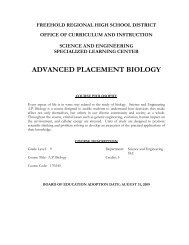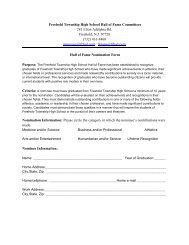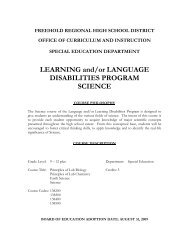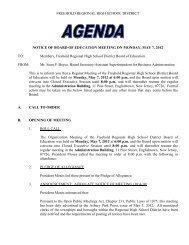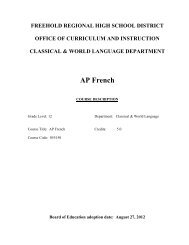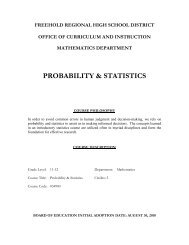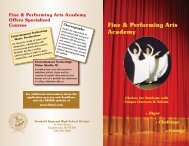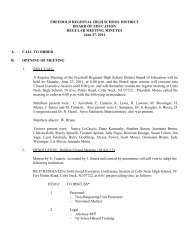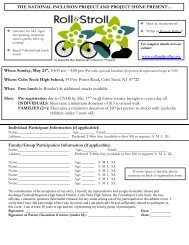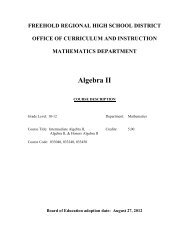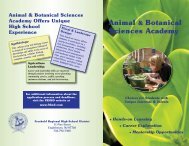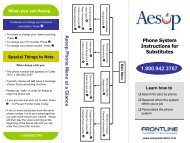AP Physics B - Freehold Regional High School District
AP Physics B - Freehold Regional High School District
AP Physics B - Freehold Regional High School District
Create successful ePaper yourself
Turn your PDF publications into a flip-book with our unique Google optimized e-Paper software.
What is the role of a"point particle","massless string"and a "frictionlesspulley"?Recognize that "masslessstrings" and "frictionlesspulleys" connect objectswithout external consequencesTextbook or supplemental material with examplesand problemsLecture and class discussionEvaluate assumptions duringproblem solving processProper use of assumptionsand models in problemsand activities2010 College‐ and Career‐ReadinessStandards and K‐12 EnglishLanguage Arts2010 College‐ and Career‐ReadinessStandards and K‐12 EnglishLanguage ArtsGrades 11‐12 Literacy inScience and Technical SubjectsGrades 11‐12 Literacy inScience and Technical SubjectsLA.11‐12.RSTLA.11‐12.WHST2009 Science Grades: 9‐12 SCI.9‐12.5.1.12 Science is both a body of knowledge and an evidence‐based, model‐building enterprise that continuallyextends, refines, and revises knowledge. The four Science Practices strands encompass the knowledgeand reasoning skills that students must acquire to be proficient in science.2009 Science Grades: 9‐12 SCI.9‐12.5.2.12 Physical science principles, including fundamental ideas about matter, energy, and motion, arepowerful conceptual tools for making sense of phenomena in physical, living, and Earth systemsscience.2009 Science Grades: 9‐12 SCI.9‐12.5.2.12.E It takes energy to change the motion of objects. The energy change is understood in terms of forces.2009 Science Grades: 9‐12 SCI.9‐12.5.2.12.E.a The motion of an object can be described by its position and velocity as functions of time and by itsaverage speed and average acceleration during intervals of time.2009 Science Grades: 9‐12 SCI.9‐12.5.2.12.E.1 Compare the calculated and measured speed, average speed, and acceleration of an object in motion,and account for differences that may exist between calculated and measured values.2009 Science Grades: 9‐12 SCI.9‐12.5.2.12.E.b Objects undergo different kinds of motion (translational, rotational, and vibrational).2009 Science Grades: 9‐12 SCI.9‐12.5.2.12.E.c The motion of an object changes only when a net force is applied.2009 Science Grades: 9‐12 SCI.9‐12.5.2.12.E.3 Create simple models to demonstrate the benefits of seatbelts using Newton's first law of motion.2009 Science Grades: 9‐12 SCI.9‐12.5.2.12.E.d The magnitude of acceleration of an object depends directly on the strength of the net force, andinversely on the mass of the object. This relationship (a=Fnet/m) is independent of the nature of theforce.2009 Science Grades: 9‐12 SCI.9‐12.5.2.12.E.4 Measure and describe the relationship between the force acting on an object and the resultingacceleration.ReadingWritingDifferentiationFacilitate group discussions to assess understanding among varying ability levels of students.Provide more opportunities for advanced calculations and conversions for advanced students.Draw and label diagrams to represent some of the data for visual learners.Provide choice to students for groups selections and roles in the groups.Provide modeling, where possible.Provide real‐life or cross‐curricular connections to the material.Provide technology (in forms of hardware, software and interactive discussion groups/forums) to facilitate data collection, analyzing and reportingconclusions).



